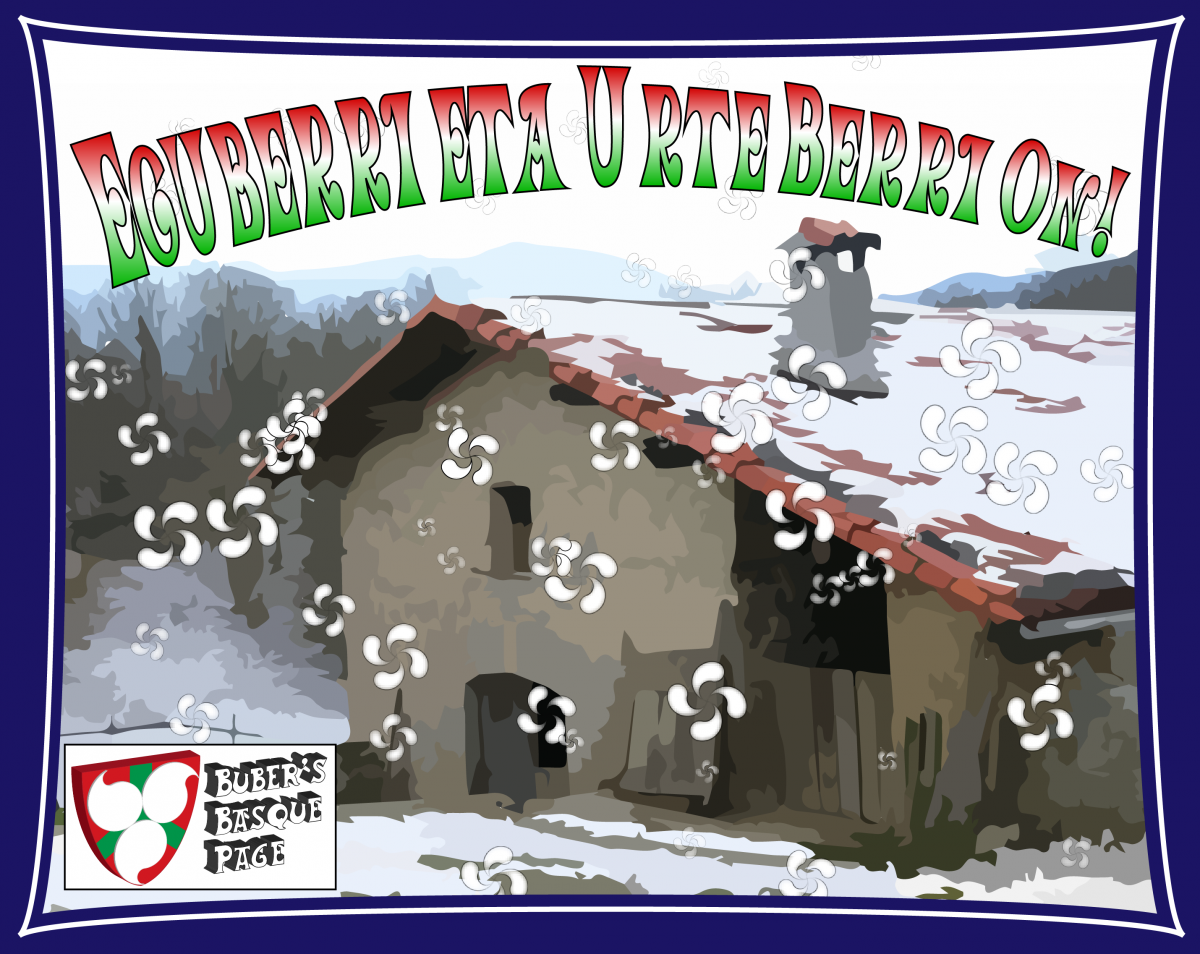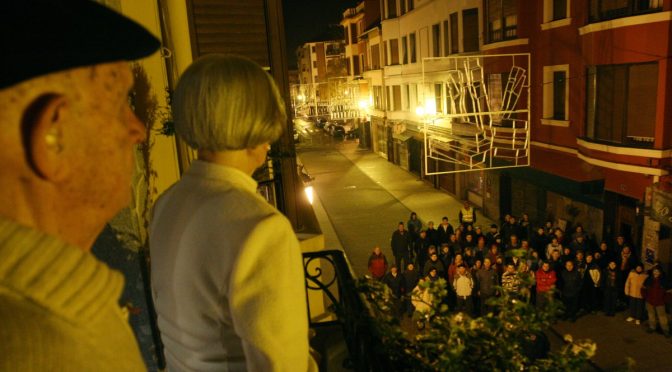Begiak noraino, nahia haraino.
As far as the eyes can see, that’s how far one’s desires go.

These proverbs were collected by Jon Aske. For the full list, along with the origin and interpretation of each proverb, click this link.

Begiak noraino, nahia haraino.
As far as the eyes can see, that’s how far one’s desires go.


Even as recently as the early 1990s, when I lived in Donostia for a year, Bilbao seemed this dirty place that wasn’t really worth a visit. I think in that whole year, I only visited a couple of times at most. However, the city transformed itself from a relic of industry to a modern and vibrant destination. Now, I can’t imagine a visit to the Basque Country without a stop in Bilbao. Though there are many factors that, together, led to this transformation, the symbolic heart of it all has to be Frank Gehry’s Guggenheim Museum.

A full list of all of Buber’s Basque Facts of the Week can be found in the Archive.
Primary sources: Frank Gehry, Wikipedia; Guggenheim Museum Bilbao, Wikipedia; Marqués de Riscal Hotel, Wikipedia


Begi bat aski du saldunak, ehun ez ditu sobera erostunak.
The seller needs but one eye, whereas for the buyer a hundred eyes are never
too many.


Singing is such a part of Basque culture. More than once, I’ve been in a restaurant where everyone broke into song. Christmas is a time when singing abounds. Leave it to the Basques to then create unique traditions around songs and Christmas. The Marijesiak is a group of singers that roam the streets of primarily but not exclusively Gernika in the early mornings of the days leading up to Christmas.

Hor goiko landetan
eperrak dabiltz kantetan
Errigoitiko alkatiari
Kaka eintziela praketan.
Hor goian Juaniko
hemen behean Periko
eta bien bitartean dago
Martzelino Polanko.
Hor goian Frantzia
Hor behean España
eta bien bitartean dago
Gora Euskadi Askatuta.
In the high lands
the partridges are singing
to the mayor of Errigoiti
that he has poop in his pants.
Up there is Juaniko
here below is Periko
and between the two is
Marzelino Polanko.
Up there is France
Down there is Spain
and in between is
Long Live a free Basque Country.
A full list of all of Buber’s Basque Facts of the Week can be found in the Archive.
Primary sources: Rementeria Arruza, Daniel. Marijeses de Gernika. Auñamendi Encyclopedia, 2025. Available at: https://aunamendi.eusko-ikaskuntza.eus/en/marijeses-de-gernika/ar-154039/; Marijesiak, Wikipedia; Marijesiak, Disfruta Bizkaia; The Marijesiak tradition in Gernika-Lumo (Bizkaia), Labayru; Gernikako Marjiesiak, Urdaibai; marijesiak.eus

Bat izatea hobe, bi itxo egitea baino.
It’s better to have one than be waiting for two.


We don’t know much about the early history of the Basques. While discoveries such as the Hand of Irulegi reveal more than ever, there is still a lot that is shadowed in the mists of time. The Basques have never recorded their own history – what we know is typically from the pens of neighbors or other observers. This includes the Romans. The Romans certainly conquered much of the Iberian peninsula, including parts of the modern day Basque Country. Indeed, Pamplona is named after the Roman general Pompey. Much of what was written back then is through the lens of the conqueror and, even worse, by people who had only heard of the Basques but never visited the region.

A full list of all of Buber’s Basque Facts of the Week can be found in the Archive.
Primary sources: Estrabón y su mención a los pueblos del norte de la Península Ibérica by María Cruz González Rodríguez, Euskonews; Brughmans, T., de Soto, P., Pažout, A. and Bjerregaard Vahlstrup, P. (2024) Itiner-e: the digital atlas of ancient roads. https://itiner-e.org/

Every once in a while, I’m going to try to highlight a different Basque music group. A mix of some of my favorite Basque songs can be found on YouTube: Buber’s Basque Mix.

Today’s band is Sua – thanks to Eneko Ennekõike for pointing me to them. Hailing from the Bizkaian town of Maruri, a small village of about 1000 people just a bit north of Bilbao, Sua is an alternative rock band known that blends “raw post-punk energy with dreamy melodies and powerful female vocals. Singing in both Basque and English, they channel themes of rebellion, inner strength, and vulnerability into a sound that is both intimate and explosive (Spotify).”
The group has released three albums – a self-titled EP in 2019, Ordu beltzak also in 2019, and Gorde genituen beldurrak in 2022. Sua, meaning “fire” in Basque, consists of Ane Barrenetxea on vocals, Janire Lopez on bass, Julen Gilbert Wright on guitar, and Esteban Gaviria on drums (Wikipedia).
They just dropped their newest single, entitled “Rollercoaster,” with lyrics in English. The song is about the emotional ups and downs of dealing with people full of doubt and features Cecilia Boström from The Baboon Show. Check it out:

Nearly none of the young men and women who immigrated to the United States from the Basque County to herd sheep in the American West had any knowledge of English. This wasn’t much of a problem as they typically worked with other Basques. However, encounters with the dominant language of their new home were unavoidable and sometimes represented concepts that they didn’t have a Basque word for, so they simply transliterated the English word into Basque spelling. This leads to an interesting collection of “Basqlish” words.
aizkrime
anburgesa
esprinkola
estorra
foki
grinjouse
karrue
kukia/kukije
morojona
mubije/mubia
paia/paije
pikapa
sanabitxe
saniskibi
sizpaka
taia/taije
troka
txip
uintxila
xata
zereala
ice cream
hamburger
sprinkler
store
the f-word
greenhouse
car
cookie
motorhome
movie
pie
pickup
son of a bitch
Thanksgiving
six pack
tire
truck
sheep
windshield
shot
cereal
A full list of all of Buber’s Basque Facts of the Week can be found in the Archive.
Primary sources: Joxe Male-Olaetxe, private communication.
Seasons greetings! Gabon Zoriontsua! We are in the heart of the holiday season and people are looking for that special gift for their Basque loved ones. Diana Echeverria had a great suggestion of creating a list of merchants and businesses that are either Basque owned or sell Basque-themed products. If you have such a business and would like to be listed in the Merkatua page, let me know and I’ll be happy to add you. I just ask that the business is either Basque owned or sells Basque-themed products.